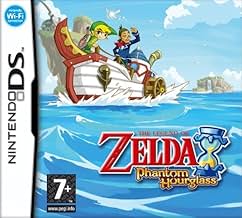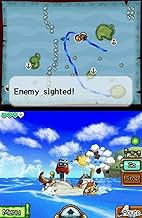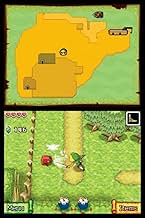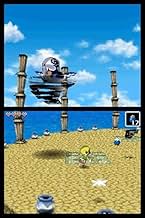IMDb रेटिंग
7.7/10
1.1 हज़ार
आपकी रेटिंग
अपनी भाषा में प्लॉट जोड़ेंLink goes on another journey to save Tetra who was kidnapped.Link goes on another journey to save Tetra who was kidnapped.Link goes on another journey to save Tetra who was kidnapped.
- पुरस्कार
- 5 जीत और कुल 1 नामांकन
कहानी
क्या आपको पता है
- ट्रिवियाAlthough many games within the Zelda series are (relatively) stand-alone games, this installment is one of the few direct sequels to an earlier title (i.e. Zeruda no densetsu: Kaze no takuto (2002)). As such, it is one of the last games in the Zelda chronology.
- गूफ़Certain enemies fly using helicopter-like rotors, but they only have one rotor. It is impossible to fly with less than 2 rotors.
फीचर्ड रिव्यू
(www.plasticpals.com) Phantom Hourglass, the first Zelda title designed for the Nintendo DS, picks up where The Windwaker left off. A comical seafaring adventure in the cel-shaded style, Phantom Hourglass makes excellent use of the DS graphical capabilities as well as its touch screen, delivering one of the best games for the system yet.
The DS begged the question, "How would a Zelda game play using the touchscreen?" and Phantom Hourglass is the answer. Eschewing both the d-pad and face buttons entirely, Phantom Hourglass can be played with the touch screen alone, with the option of using the L button for readying secondary items. This is a big change, but die-hard Zelda fans can breathe easily as the controls couldn't feel any more natural.
Link will move wherever you touch the screen, and attack enemies when you tap on them with your stylus. You can also perform fancier moves, such as the spin-slash by drawing a circle around him. Where things get really interesting (and innovative) is how the player uses secondary items such as bombs, arrows, and the boomerang. It's amazing how intuitive the controls are for each item and in most cases it's an improvement over the typical 2D Zelda control mechanisms.
One of the coolest additions to the game play is the ability to draw on the map screen. Clues for solving a puzzle can be quickly jotted down, or the location of buried treasure can be sketched onto the map. This isn't just a gimmick as you'll be making memos throughout the entire game. X marks the spot!
Phantom Hourglass even improves on game play specific to The Windwaker. Instead of having to conduct the wind to sail around the ocean, players simply plot their course by drawing a line on the map. Tapping enemies that attack you on the high seas will fire the cannons with surprising accuracy. You can even upgrade and customize your ship with dozens of different parts.
The best new addition to seafaring is dragging up treasure from the deep. In The Windwaker, you simply navigated to the spot marked on your map and the treasure was yours. In Phantom Hourglass, you now get to control the salvage arm as it drops below the water's surface. Collecting each buried treasure plays out like a mini-game where you have to avoid mines and rocky cliffs while snagging rupees, until finally latching onto the treasure chest on the sea floor!
Key to solving the mysteries of the game is delving deeper and deeper into the Temple of the Ocean King. Unfortunately, the temple is cursed – anyone who dares to venture inside will have their life drained – and there are Phantoms about who mean serious business! This is where the titular Phantom Hourglass comes into play. The hourglass prevents your life from being drained for a time (just how much time is determined by how much special sand you have collected). Making things a bit easier are safety zones which pause the timer and prevent Phantoms from seeing you.
It's a bit of a chore to return inside the temple (which players must do at least 5 times throughout the game), but the handy warp points and Link's arsenal of items provide for handy shortcuts, cutting down on the back-tracking quite a bit.
The DS isn't exactly known for its power (often playing second fiddle to the PSP) but Phantom Hourglass looks and sounds like a portable version of The Windwaker. It may be a little rough around the edges, but it does a great job overall. Characters are especially expressive by DS standards, and the bosses and cinematics (often stretching across both screens) are a sight to behold.
Enticing non-gamers to play is Nintendo's mandate, and Phantom Hourglass could be described as an "entry level" Zelda game. Relying entirely on touch screen controls required a simpler design, and some traditional Zelda elements were truncated as a result. Dungeons are linear, puzzles are easier, and enemies don't put up much of a fight. That said, the game is still fun to play, the bosses are epic even by Zelda's standards and the mini games will test even the best player's skill with the touch- screen. For my money, Phantom Hourglass is one of the best DS titles available, and a solid if not spectacular addition to the Zelda franchise.
The DS begged the question, "How would a Zelda game play using the touchscreen?" and Phantom Hourglass is the answer. Eschewing both the d-pad and face buttons entirely, Phantom Hourglass can be played with the touch screen alone, with the option of using the L button for readying secondary items. This is a big change, but die-hard Zelda fans can breathe easily as the controls couldn't feel any more natural.
Link will move wherever you touch the screen, and attack enemies when you tap on them with your stylus. You can also perform fancier moves, such as the spin-slash by drawing a circle around him. Where things get really interesting (and innovative) is how the player uses secondary items such as bombs, arrows, and the boomerang. It's amazing how intuitive the controls are for each item and in most cases it's an improvement over the typical 2D Zelda control mechanisms.
One of the coolest additions to the game play is the ability to draw on the map screen. Clues for solving a puzzle can be quickly jotted down, or the location of buried treasure can be sketched onto the map. This isn't just a gimmick as you'll be making memos throughout the entire game. X marks the spot!
Phantom Hourglass even improves on game play specific to The Windwaker. Instead of having to conduct the wind to sail around the ocean, players simply plot their course by drawing a line on the map. Tapping enemies that attack you on the high seas will fire the cannons with surprising accuracy. You can even upgrade and customize your ship with dozens of different parts.
The best new addition to seafaring is dragging up treasure from the deep. In The Windwaker, you simply navigated to the spot marked on your map and the treasure was yours. In Phantom Hourglass, you now get to control the salvage arm as it drops below the water's surface. Collecting each buried treasure plays out like a mini-game where you have to avoid mines and rocky cliffs while snagging rupees, until finally latching onto the treasure chest on the sea floor!
Key to solving the mysteries of the game is delving deeper and deeper into the Temple of the Ocean King. Unfortunately, the temple is cursed – anyone who dares to venture inside will have their life drained – and there are Phantoms about who mean serious business! This is where the titular Phantom Hourglass comes into play. The hourglass prevents your life from being drained for a time (just how much time is determined by how much special sand you have collected). Making things a bit easier are safety zones which pause the timer and prevent Phantoms from seeing you.
It's a bit of a chore to return inside the temple (which players must do at least 5 times throughout the game), but the handy warp points and Link's arsenal of items provide for handy shortcuts, cutting down on the back-tracking quite a bit.
The DS isn't exactly known for its power (often playing second fiddle to the PSP) but Phantom Hourglass looks and sounds like a portable version of The Windwaker. It may be a little rough around the edges, but it does a great job overall. Characters are especially expressive by DS standards, and the bosses and cinematics (often stretching across both screens) are a sight to behold.
Enticing non-gamers to play is Nintendo's mandate, and Phantom Hourglass could be described as an "entry level" Zelda game. Relying entirely on touch screen controls required a simpler design, and some traditional Zelda elements were truncated as a result. Dungeons are linear, puzzles are easier, and enemies don't put up much of a fight. That said, the game is still fun to play, the bosses are epic even by Zelda's standards and the mini games will test even the best player's skill with the touch- screen. For my money, Phantom Hourglass is one of the best DS titles available, and a solid if not spectacular addition to the Zelda franchise.
- robotbling
- 27 नव॰ 2012
- परमालिंक
टॉप पसंद
रेटिंग देने के लिए साइन-इन करें और वैयक्तिकृत सुझावों के लिए वॉचलिस्ट करें
विवरण
- रिलीज़ की तारीख़
- कंट्री ऑफ़ ओरिजिन
- भाषा
- इस रूप में भी जाना जाता है
- The Legend of Zelda: Phantom Hourglass
- उत्पादन कंपनी
- IMDbPro पर और कंपनी क्रेडिट देखें
- रंग
इस पेज में योगदान दें
किसी बदलाव का सुझाव दें या अनुपलब्ध कॉन्टेंट जोड़ें


















